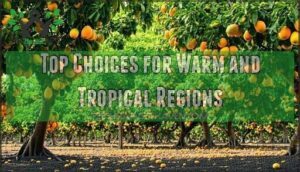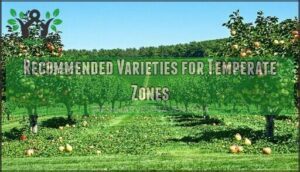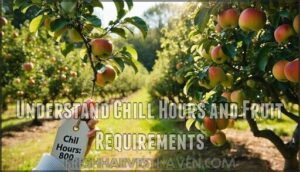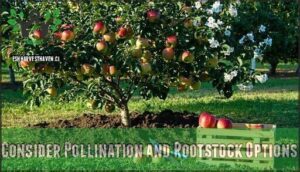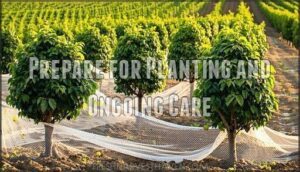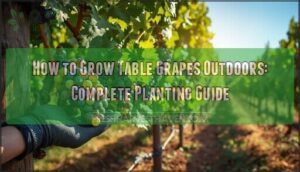This site is supported by our readers. We may earn a commission, at no cost to you, if you purchase through links.

A tree happy in the South might struggle in the Mountain states, while a certain apple that does well in New England might suffer in the heat of Florida. Selecting the right fruit for your area isn’t just about choosing what catches your eye in a catalog. It’s about aligning a tree’s biological needs with your environment—knowing your hardiness zone, chill hours, humidity levels, and common diseases.
When you find the right match, your trees will reward you with plentiful harvests each year. If you don’t, you’ll be constantly battling against nature. This guide will walk you through the steps to understand your climate, interpret fruit tree needs, and pick varieties that will actually thrive in your backyard.
Table Of Contents
- Key Takeaways
- Assess Your Climate and Hardiness Zone
- Match Fruit Varieties to Your Region
- Understand Chill Hours and Fruit Requirements
- Select Healthy and Disease-Resistant Trees
- Consider Pollination and Rootstock Options
- Prepare for Planting and Ongoing Care
- Frequently Asked Questions (FAQs)
- How to choose a fruit tree?
- Which fruit trees thrive in cold winters?
- Why should you consider growing fruit trees?
- Which fruit trees are rated for a heat zone?
- What fruit trees can you grow in America?
- What factors should you consider when selecting a fruit tree?
- What fruits can grow in any climate?
- How do I choose a good fruit tree?
- What not to plant next to fruit trees?
- Which fruit is good for hot climate?
- Conclusion
Key Takeaways
- Selecting fruit trees starts with knowing your USDA hardiness zone and calculating your area’s chill hours—the cumulative cold period between 32°F and 50°F that trees need to break dormancy and produce fruit.
- Matching varieties to your specific climate prevents years of disappointment, since a peach thriving in mild winters won’t fruit in areas lacking sufficient chill hours, while cold-hardy apples fail in tropical heat.
- Disease-resistant cultivars can reduce pesticide use by up to 65% and crop losses by 40%, making them both economically smart and environmentally responsible choices for home orchards.
- Understanding whether your tree is self-fertile or requires cross-pollination partners planted within 50 feet determines whether you’ll get fruit at all, so plan your orchard layout before you dig the first hole.
Assess Your Climate and Hardiness Zone
Before planting a single tree, it’s important to know what your yard can realistically handle. Your climate and hardiness zone will determine which fruit varieties will flourish versus those that will struggle or completely fail.
Let’s go over how to evaluate your growing conditions, so you can make informed decisions from the get-go.
Identifying Your USDA Hardiness Zone
Before planting any trees, determine your USDA Hardiness Zone—think of it as a ZIP code that tells you which plants will flourish in your garden and which will struggle.
The USDA Plant Hardiness Zone Map categorizes regions by average annual minimum temperatures, which helps you figure out what plants can withstand your winters.
Just go to the USDA’s online tool, type in your address, and your zone appears instantly—it’s that simple.
Understanding Microclimates in Your Yard
Your hardiness zone gives you the big picture, but your yard holds its own secrets—pockets where a frost-tender fig might thrive against a south-facing wall, or a low spot where cold air settles and damages blooms.
Walk your property and map these microclimates: note sun exposure throughout the day, wind protection from fences or buildings, soil variation, water drainage patterns, and frost pockets where cold collects, then match your fruit varieties to these unique growing conditions.
Impact of Temperature and Humidity on Fruit Trees
Temperature and humidity work hand-in-hand—get the balance wrong, and even a properly zoned tree can fall victim to disease, disappointing harvests, or chronic stress.
In muggy climates, excessive moisture invites fungal problems, while arid heat weakens trees that aren’t watered enough.
A surprise cold spell can wipe out blossoms overnight, and wild temperature swings throw off the tree’s natural dormancy cycle.
You’ll want varieties bred for your climate—otherwise, you’re fighting nature from day one.
Pick cultivars that match your region’s quirks, and tweak microclimates around each tree (think strategic shade, windbreaks, or mulch) to soften humidity and temperature extremes.
Match Fruit Varieties to Your Region
Once you know your hardiness zone, you can match specific fruit varieties to your region’s growing conditions. Cold climates, warm tropical areas, and temperate zones each nurture different types of fruit trees.
Let’s see which varieties flourish where you live.
Best Fruit Trees for Cold Climates
Cold climates don’t mean giving up on fruit trees—they just require smarter choices. For USDA hardiness zones 3–5, select cold-hardy apples like ‘Honeycrisp,’ ‘Liberty,’ or ‘Freedom.’ These varieties withstand brutal winters and resist common diseases like apple scab. Pair them with cold-tolerant rootstocks such as Antonovka 313 for extra winter protection.
Remember chill hours—apples typically need 200–1,000 hours between 32°F and 50°F to produce fruit. Self-fertile options like sour cherries simplify pollination strategies in isolated yards.
For success, consider planting cold hardy varieties that are specifically adapted to colder temperatures.
Top Choices for Warm and Tropical Regions
In warm, tropical climates—zones 9–13—low-chill varieties flourish without long cold spells. Mango trees thrive where it’s consistently warmer than 70°F; disease-resistant types like ‘Nam Doc Mai’ can cut anthracnose by 70%.
Papaya, citrus, and guava are self-fertile, which makes pollination easy. You can also grow apple trees pesticide-free by using organic pest control methods.
Choose varieties suited to your zone—you’ll see healthier trees, fewer disease problems, and consistent fruit production in tropical conditions.
Recommended Varieties for Temperate Zones
In temperate zones 4–7, apple cultivars like ‘Honeycrisp’ and ‘Goldrush’ flourish with 800–1,000 chill hours and resist common diseases.
Pear selections such as ‘Bartlett’ and plum varieties including ‘Stanley’ provide reliable yields.
For cherry choices, self-fertile ‘Lapins’ excels, while berry options like ‘Bluecrop’ blueberries yield 7–10 pounds per bush annually.
All of these varieties thrive in temperate climates, making them solid picks for zones 4–7.
Understand Chill Hours and Fruit Requirements
Chill hours aren’t just a curiosity—they determine whether your fruit tree will produce a harvest or simply survive as an ornamental. Different varieties have vastly different cold requirements, and matching these needs to your local winter temperatures is the difference between abundance and disappointment.
I’ll explain how to calculate your area’s chill hours and select varieties that will actually thrive.
Calculating Local Chill Hours
You won’t succeed by guessing when it comes to chill hours—you have to track them, but it’s easier than you might expect. Begin by reviewing past weather data for your plant hardiness zone using local extension offices or online chill hour trackers.
These tools watch temperature patterns between 32°F and 45°F during dormancy breaking periods. Local chill variations are important. The impact of climate change suggests past data won’t always predict future conditions, so annual temperature monitoring keeps your climate compatibility assessments accurate.
Low-Chill Vs. High-Chill Fruit Varieties
Matching varieties to chill requirements isn’t about compromise—it’s the difference between a tree that thrives and one that barely survives. Low-chill fruit tree varieties need 200-400 chill hours, suiting warm climate zones where winters stay mild. High-chill varieties demand 800-1700 hours, matching cold hardiness zones perfectly.
Key Variety Adaptation Factors:
- Low-chill regional cultivars excel in USDA hardiness zones 8-10, where dormancy requirements stay minimal
- High-chill varieties suit zones 3-6, meeting extended dormancy requirements naturally
- Climate change effects shift traditional chill hour patterns, requiring flexible cultivar selection
- Chill hour impact determines fruit quality—mismatched trees produce poorly or skip fruiting entirely
Chill Hour Needs of Popular Fruits
Each fruit tree variety has its own chilling requirement. Apple trees generally need 800–1,000 chill hours, though ‘Anna’ gets by with only 200–400. Peach trees need anywhere from 200–800 hours of chill depending on the cultivar. Cherry trees need between 300–1,000 chill hours, while pear and plum trees need 250–900 hours.
Berry and nut crops vary considerably—blueberries need 150–700 hours, while walnuts need 700 hours or more. Matching these chilling needs to your USDA hardiness zone will determine if your fruit trees will thrive or disappoint.
Select Healthy and Disease-Resistant Trees
Finding a healthy tree at the start makes all the difference in how well it grows and produces fruit. Let’s walk through the key steps to picking strong, resilient trees that thrive in your garden.
You’ll want to know what to look for when you’re shopping, why disease resistance matters, and where to buy with confidence.
How to Inspect Tree Health Before Buying
Buying a healthy tree from a nursery sets you up for success—skip this step, and you’re building on shaky ground from day one.
When picking out healthy fruit trees at local nurseries, start by checking the roots to make sure they don’t circle the pot or have any damage. Also, make sure the tree is structurally sound by checking for branches that are spaced well and a trunk that’s straight.
Take a look at the leaves for any discoloration or spots, which could mean the tree isn’t healthy. Look closely for signs of pests, like webbing or holes, and examine the bark for any cracks or injuries on your nursery stock.
Benefits of Disease-Resistant Cultivars
Once you’ve found a solid, healthy tree, your next move is choosing disease-resistant varieties. The payoff is real: these cultivars can slash pesticide use by up to 65% and cut crop losses by 40% in apples and peaches.
Disease resistance brings:
- Pesticide Reduction – Fewer sprays mean lower chemical costs and safer fruit.
- Yield Stability – Resistant varieties cut yield swings by 30% under changing weather.
- Economic Advantages – Growers save on labor and see ROI improvements averaging 18% within five years.
- Environmental Impact – Orchards lower groundwater contamination by 45% and reduce their carbon footprint by 22%.
There’s a bonus here too: resistant varieties can unlock better prices. Organic growers often see 10–15% premiums for certified low-input fruit—a nice edge when you’re competing in farmers’ markets or specialty channels.
Choosing Reliable Nurseries and Sources
Once you’ve narrowed down the best varieties for disease resistance, your next priority is finding a reliable place to purchase your trees. A nursery’s reputation is important—seek out fruit tree sellers with certified stock and good feedback.
Online retailers are convenient, but carefully check bare-root options for healthy roots. Buying from a local nursery lets you examine each fruit tree before you pay, and negotiating prices on less-than-perfect trees can save you money while still ensuring quality.
Consider Pollination and Rootstock Options
After selecting a healthy tree, consider how it reproduces and grows. Some fruit trees need a nearby partner to bear fruit, while others are self-pollinating.
Also, the rootstock your tree is grafted onto will influence its size, vigor, and how well it adjusts to your soil.
Self-Fertile Vs. Cross-Pollinating Varieties
When planning your fruit tree garden, knowing if your chosen varieties are self-fertile or need a partner for pollination can be the difference between a big harvest and empty branches in the fall. Self-fertile trees bear fruit using their own pollen, which gives you options if you don’t have much space.
Trees that need cross-pollination depend on compatible varieties nearby—ones that bloom at the same time and can swap genetically diverse pollen. Without that match, you won’t get fruit.
So before you plant, figure out which trees work together.
Planning for Pollination Partners
If your tree is unable to pollinate on its own, you’ll have to act as a matchmaker by picking a suitable partner. It should flower at the same time and be near enough for bees to move pollen between them. This is how to plan for successful cross-pollination:
- Consult pollen compatibility charts to be sure your varieties can fertilize one another
- Synchronize bloom dates so flowers are open together during the same period
- Plant pollination partners within 50 feet for effective pollen movement
- Get at least two compatible varieties that flower at the same time
- Think about grafting multiple varieties onto one tree to conserve space
Attractants for insect pollinators, like flowering herbs planted close by, can further improve cross-pollination.
Rootstock Types and Their Impact on Growth
The rootstock you select affects how tall your tree will get, how soon it produces fruit, and even its ability to thrive in your soil. Dwarf rootstocks result in manageable mature sizes, often only 8 to 10 feet tall, while semidwarf types provide a balance of medium height and quicker fruiting. Standard rootstocks yield full-sized trees that have longer lifespans but need more room.
Always check that the rootstock suits your climate and the tree varieties you’ve chosen for the best disease resistance.
Prepare for Planting and Ongoing Care
Once you’ve chosen the right varieties for your area, the real work begins. A strong start for your trees requires understanding how to prune, water, and protect them from common problems.
Let’s consider the essential steps that will help your fruit trees flourish for years.
Pruning and Training Young Trees
Pruning a young fruit tree is like teaching a child good posture—what you establish in those first few years shapes its growth for decades.
What you shape in those early years determines your tree’s structure for decades to come
During the first four to five years, concentrate on training techniques like "open center" or "central leader" to build a strong structure.
Use sharp pruning tools to make clean cuts when shaping branches, and remember that early pruning lays the groundwork for future harvests across all tree types.
Watering, Sunlight, and Pest Prevention
After all that early training, your fruit trees need three daily essentials—water, sunshine, and protection from hungry pests—to turn those promising branches into a productive orchard.
To keep your trees thriving in your climate zone, consider the following:
- Watering Techniques: Deep watering encourages strong roots, but don’t drown the soil—adjust frequency based on rainfall and temperature.
- Sunlight Exposure: Position trees where they’ll soak up 6 to 8 hours of direct sunlight daily for quality fruit production.
- Pest Management: Regular inspections catch problems early, preventing damage before it spreads through your orchard.
- Disease Control: Healthy soil creates resilient trees that naturally resist common threats in your region.
Frequently Asked Questions (FAQs)
How to choose a fruit tree?
Think of choosing a tree like finding the right match—it’s all about compatibility.
Start by inspecting the age and roots. Look for healthy, untangled root systems without any signs of disease.
Go for disease-resistant varieties that match your local climate, check out different flavor profiles, and don’t be shy about negotiating price with sellers.
Which fruit trees thrive in cold winters?
Apple, pear, and sour cherry trees are hardy types that do very well producing fruit in colder areas.
These trees, which can withstand frost, need a specific amount of cold weather—generally 800 to 1,200 hours between 32 and 45 degrees Fahrenheit—to properly end their dormancy and yield good fruit.
Why should you consider growing fruit trees?
Growing your own fruit trees means fresh food straight from the garden, promotes eco-friendly living, and is great for your health.
Besides providing fruit, these trees beautify your yard while connecting you to your local weather and growing conditions.
Which fruit trees are rated for a heat zone?
Want trees that flourish in intense heat? Heat-loving types like pomegranate, fig, and citrus do great in desert climates, but they’ll need protection from sunburn and careful watering.
Knowing about climate zones and plant hardiness will help you choose fruit trees suited to your soil and local environment.
What fruit trees can you grow in America?
Across America, the varying plant hardiness zones allow for a wide array of fruit trees, from hardy apples and pears up North to citrus and figs down South.
For gardeners nationwide, container fruit trees and heritage varieties offer even more choices.
What factors should you consider when selecting a fruit tree?
Choosing the ideal apple from a tree is similar to selecting a fruit tree, as it requires careful consideration of several things.
Think about your hardiness zone, how much space you have, the tree’s mature size, how much care it will need, the required cold hours, pest resistance, fruit flavor, and how well it adapts to your area to make sure you pick the right plant.
What fruits can grow in any climate?
While no single fruit grows well everywhere, adaptable types like figs and strawberries can handle various conditions.
Growing fruit in containers and greenhouses broadens possibilities, and grafting and hydroponics help overcome climate limitations.
How do I choose a good fruit tree?
When buying fruit trees, start by checking the age and the roots. Younger trees are easier to shape and get established. Inspect the roots for any circling or damage.
Next, look over the trunk and branches. Watch for disease signs—cankers, odd discoloration, anything that looks off.
Consider the variety’s characteristics, matching them to your local climate, including its cold requirements and disease resistance.
Feel free to negotiate on trees that aren’t in tip-top shape.
What not to plant next to fruit trees?
Imagine walking through your orchard and noticing your fruit trees struggling because of bad neighbors. Avoid allelopathic plant interactions by staying away from black walnut, which releases toxins that harm tree health.
Don’t plant pest-harboring plants like brassicas, which attract unwanted insects. Select companions carefully—competing root systems and nutrient depletion can weaken growth, while tall plants cast shade that reduces fruit production and encourages plant diseases.
Which fruit is good for hot climate?
Citrus, figs, and pomegranates flourish in hot climates if you give them the right irrigation and soil management.
Dates and other heat-loving fruits do great in dry areas, while mangoes do best in the tropics.
Matching plants to the climate is key for success.
Conclusion
Picking fruit trees for your climate isn’t complicated—know your hardiness zone, how much winter chill you get, and what grows well locally.
Get those three things right, and the rest falls into place.
Start with one or two trees that are a good fit, watch them grow, and add more later. Your patience will pay off with plenty of fruit every season, all because you took the time to match the right tree to your land.
- https://homesteadandchill.com/how-to-choose-fruit-trees
- https://greg.app/fruit-trees-hardiness-zone
- https://planthardiness.ars.usda.gov
- https://www.farmstandapp.com/66795/7-best-fruit-tree-varieties-for-your-climate
- https://www.foodforestnursery.com/shop/fruit-trees/by-climate-zone/fruit-trees-for-zone-8


